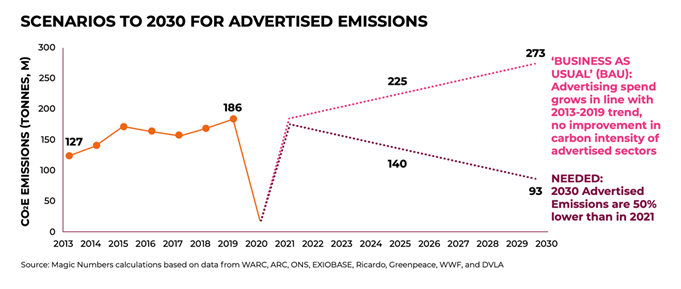
Advertised Emissions
9 November 2021Last year, we introduced the idea of Ecoffectiveness using Audi’s IPA Effectiveness Grand Prix as a case study, to quantify the additional carbon that results from the uplift in sales generated by advertising. Since then we’ve been working agencies and clients within the industry and have started to see real traction in forward thinking strategy and client teams taking this to their clients and putting it at the heart of their measurement.
A year on we wanted to take the next step - to move from one campaign to the whole industry. We’ve borrowed from the idea of Financed Emissions, already well established in the finance industry. So, if HSBC helps finance the development of a new coal-fired power station, then the emissions associated with building and running that power station are part of HSBC’s Financed Emissions.
Our new report introduces the idea of Advertised Emissions - which is defined as greenhouse gas (GHG) emissions that result from the uplift in sales generated by advertising. To help stimulate a fact-based discussion, we’ve worked with leading econometrics agency, Magic Numbers, to calculate the Advertised Emissions for the UK advertising industry.
We used data from ARC – a massive database of everyday econometric evaluations that accounts for more than £5 billion in advertising spend - to help us isolate the total uplift in demand generated by 2019’s advertising across 19 sectors. By combining this data with carbon intensity and other environmental lifecycle data, we could calculate the total uplift in carbon emissions triggered by all the advertising in the UK.
Our research confirms that advertising plays a significant positive role in the UK economy. We estimate that nearly £90bn worth of products were sold because of advertising in 2019 – that’s a full 4% of GDP, or c.£6.30 worth of economic activity per £1 spent on advertising.
But there are knock-on effects for climate change. Incremental sales mean that advertisers make more products and services, and their suppliers make more, and their suppliers too. At every stage, this leads to more emissions of greenhouse gases.
Once all of those global impacts are added up, the total is 186 million tonnes - equivalent to half the UK’s annual domestically produced emissions.
And because the data comes from sales that wouldn’t have happened without advertising, we can also calculate that advertising added 28% to the annual carbon footprint of every single person in the UK.
So what can we do about it?
If what gets measured gets managed, getting the action right starts with getting the measurement right. But up until now, there hasn’t been a measure of the climate impact of additional sales generated by advertising.
So far, advertising and media agencies have only been thinking about the emissions that arise from them having ideas, making plans, creating copies, and then airing ads on TV or printing them in newspapers. Reducing these is a good first step, and WPP, Dentsu, IPG, Publicis, and Havas all have commitments in place.
But ‘Advertised Emissions’ – the emissions that arise from additional sales generated by advertising – dwarf other types of emissions from advertising. Our estimate shows that in 2019 they were 186 times bigger than operational emissions from advertising agencies and similar businesses (at only 1m tonnes).

We have projected that if advertising-as-usual continues, Advertised Emissions will be more than 270m tonnes by 2030, with most emissions coming from the categories that spend a lot on advertising, enjoy a strong return on investment, and have carbon intensive production and supply chains:
- Retail (from supermarkets to high street chains)
- Technology and electronics
- Transport and tourism
- Leisure and entertainment
In all categories, but especially those listed above, marketers need to do four things:
First, help our clients transition to cleaner production processes and supply chains by engineering the demand for the products they produce. A great example of this type of campaign is P&G’s Ariel ‘Turn to 30°’ campaign, which helped cut 58,000 tonnes of CO2e by educating consumers to save energy .
Second, accelerate acceptance and adoption of new models where products are used for longer before being disposed of. This means promoting initiatives like IKEA’s ‘buy back and resell’ service.
Third, support, promote, and energise low or zero-carbon brands and industries whose business model is geared to serving a 1.5-degree world. This means supporting brands like Quorn who recently saved 3.8m kg of emissions by encouraging a switch away from meat .
And finally, there are some rare brands and sectors whose production is high-carbon with no hope of transitioning to a cleaner production process. Marketers and the advertising industry together need to reduce or even remove spending that supports these businesses.
We are already engaging with all our clients to understand the impact our work is having – and our growing Future Strategy team is working with many of them to identify strategic and innovative opportunities to transition. Read the full report here.






